Sycamore Trees: Leaves, Bark, Types – Identification Guide (Pictures)

Sycamore trees are huge deciduous trees with a broad, rounded crown of lush green foliage. Sycamore trees have serrated lobed leaves that resemble maple leaves with three to five lobes. Sycamores have thin, peeling reddish-brown bark and seed balls that drop in spring. Sycamore trees grow to between 100 and 130 ft. (30 – 40 m) tall.
Sycamore trees are common throughout North America. The American sycamore tree (Platanus occidentalis) grows mainly in the eastern and central parts of United States. The Californian sycamore tree (Platanus racemosa) and Mexican sycamore tree (Platanus mexicana) are more common in the western parts of United States.
This article is a complete guide to species of sycamore trees. Pictures and descriptions will help you identify the best sycamore trees for your garden landscape.
What Are Sycamore Trees?

Sycamore tree
Sycamore trees are flowering trees in the plant genus Platanus and the family Platanaceae. Sycamore trees are often known as plane trees. These massive broad-leafed trees grow to between 100 and 130 ft. (30 – 40 m) tall. Sycamore trees are generally easy to identify due to their bark that peels away, revealing whitish or orangey patches.
Facts About Sycamore Trees
There are about six species of sycamore trees in the Platanus genus. The most common sycamore trees are the American sycamore (Platanus occidentalis), Mexican sycamore (Platanus mexicana), and California Sycamore tree (Platanus racemosa).
Some tree species that are not in the Platanus genus are also called sycamore – these are the sycamore maple (Acer pseudoplatanus), and sycamore fig (Ficus sycomorus).
Sycamore trees are fast-growing popular deciduous shade trees in city landscapes and parks. In fact, Sycamore trees are one of the largest deciduous trees native to North America. Due to their enormous size, sycamores are not common types of trees in residential gardens.
Sycamore tree timber is a hardwood with a coarse grain. Sycamore wood is used to make musical instruments, butcher’s blocks, and furniture.
Sycamore trees are prone to fungal diseases as they grow. In time, the mature trees tend to become hollow.
The two unique identifying features of sycamore trees are their exfoliating thin bark that gives the tree a patchy look, and their round seed balls or pods that contain downy tufts of seeds.
Sycamore Tree Leaves

Sycamore leaf with 3 lobes (left) and sycamore leaves in autumn (right)
Sycamore trees have large serrated lobed leaves that are light-green with three or five lobes. The lobed leaves have prominent veins running to their pointed tip. Sycamore leaves grow alternately and they turn yellow and then brown in the fall. The leaves grow to between 4” and 7” (10 – 17 cm) in diameter.
Sycamore tree leaves grow alternately—meaning that a single leaf attaches to one spot on the stem. The leaves grow in a staggered, alternating pattern along tree stems. Overall, sycamore tree leaves have an oval shape with pointed lobes and they resemble maple leaves.
Sycamore tree leaves vs. maple tree leaves
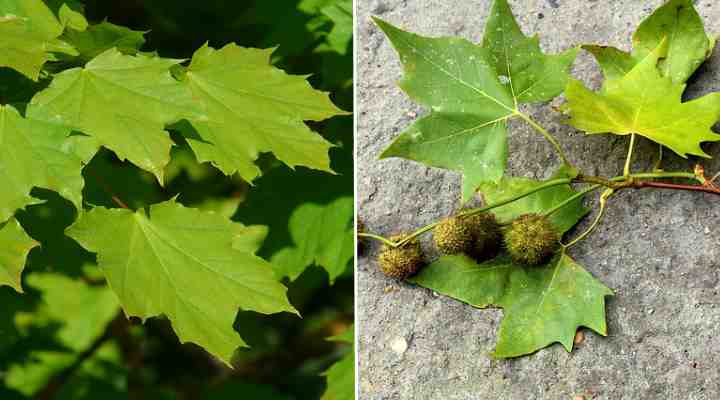
Some types of maple tree leaves (left) are very similar to sycamore leaves (right)
Sycamore trees and maple trees have leaves that look similar. Generally, sycamore trees have leaves with shallow indentations between their lobes whereas maple tree leaves have deep indentations. Sycamore tree leaves grow alternately, but maple tree leaves have an opposite leaf arrangement.
Sycamore Tree Bark
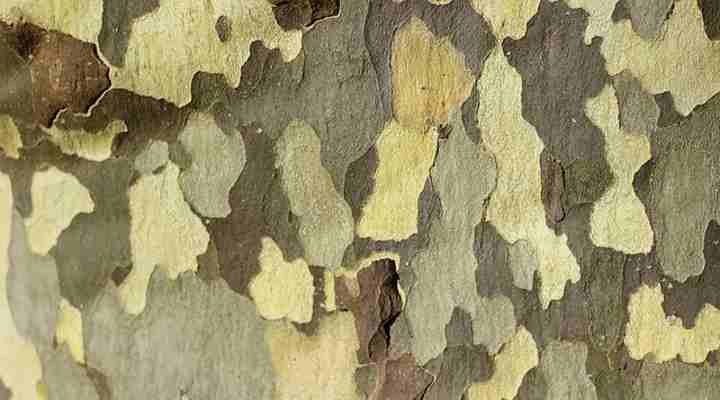
A close up picture of sycamore bark
Sycamore tree bark is thin and flaky and exfoliates in patches. The mottled bark gives sycamore tree trunks a camouflage appearance with the trunk displaying patches of white, brown, tan, and gray colors. The distinctive look of sycamore tree bark makes them easy to identify in deciduous forests or parks.
Sycamore Tree Balls

Mature sycamore tree balls
Sycamore trees produce spiky seed balls that measure 1” (2.5 cm) in diameter. Initially, the sycamore seed balls have green color but they later change to brown. The seed balls appear on the tree in late fall or winter and fall to the ground in the spring. Sycamore balls contain tufts of fluffy tiny winged seeds. The seeds disperse easily in spring when the brown balls fall to the ground.
How to Identify Sycamore Trees
The best way to identify sycamore trees is by their mottled, peeling bark that gives the tree a scabby look. Sycamore leaves have three or five lobes and are light green to dark green. In winter, sycamore trees are easy to spot due to the brown balls hanging from bare stems.
Identify sycamore trees by their leaves: Sycamore tree leaves are three or five-lobed leaves with broad shallow indentations that have an overall oval shape. Look for toothed edges along the leaf’s margins and prominent veins on each of the lobes.
Identify sycamore trees by their bark: Sycamore tree bark is smooth without fissuring. Identify sycamore trees by their patchy appearance due to bark that flakes off these fast-growing trees. Usually, the bark color is a combination of white, gray, brown, and tan.
Identify sycamore trees by their seed balls: Sycamore trees produce small brown seed balls that hang prominently from branches throughout the winter before dropping in spring.
Types of Sycamore Trees (With Pictures)
Here are descriptions of the eight species of sycamore trees popular in parks, cities, and woodlands.
American Sycamore Tree (Platanus occidentalis)

American sycamore (Platanus occidentalis) tree
American sycamore trees are massive broad-leafed trees with a vast irregular rounded crown. American sycamore trees grow to between 100 and 131 ft. (30 – 40 m) and have a wide thick trunk. Many American sycamore trees have trunks that divide near the ground, giving the tree a multi-stemmed appearance.
American sycamore trees thrive in full sun and grow best in USDA zones 4 – 9. Grow these stately trees in moist soil that is well-draining.
Common names for American sycamore trees include buttonwood trees, western plane trees, American plane tree, and water beech.
American sycamore trees mainly grow in the eastern United States. The large trees grow along streams and rivers and are often found in wetland areas. American sycamore trees used to be planted as shade trees in cities. However, their roots have a destructive effect on sidewalks and building foundations.
American sycamore trees produce brown spiked balls that hang on bare slender stems. These sycamore balls drop in spring, giving way to inconspicuous flower clusters.
The foliage of American sycamore trees is a vast crown of large leaves. The leaves start as light green in spring before becoming dark green in summer. In the fall, American sycamore leaves turn an unimpressive yellow-brown color.
Sycamore tree leaves: American sycamore tree leaves are an ovate shape with three or five lobes and they have medium to dark green color. The sinuses or indentations between lobes are shallow. American sycamore leaves are 4” to 9” (10 – 23 cm) long and look like maples leaves.
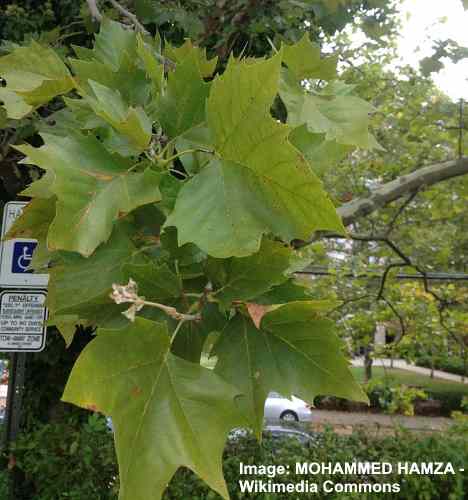
American sycamore leaves
Sycamore tree bark: American sycamore tree bark is reddish-brown that peels off in long strips. The irregular mottling on the tree reveals white or gray bark underneath. This bark’s “camouflage” effect allows for easy identification.

American sycamore bark
Mexican Sycamore Tree (Platanus mexicana)
Mexican sycamore trees are large, fast-growing trees with flaky bark and lobed maple-like leaves. Mexican sycamore trees are smaller than American sycamore and grow to between 40 and 50 ft. (12 – 15 m) with a trunk of 7 ft. (2 m) in diameter. This sycamore species tolerates heat better than American sycamores.
Mexican sycamore trees are popular in the western United States. Mexican sycamore trees thrive in full sun and are suitable for growing in zones 5 to 9.
As with all species of sycamore, Platanus mexicana grows near rivers and streams. Despite this fact, the sycamore species is also tolerant of drought when established.
The Mexican sycamore can grow in large residential gardens as an ornamental tree because it doesn’t grow as tall as the American sycamore. However, the roots of the Mexican sycamore tree can be aggressive, and the tree shouldn’t grow near buildings or other structures.
Sycamore tree leaves: Mexican sycamore tree leaves are a glossy green color on the upper sides and silvery green on the underside. The five-lobed leaves have shallow notches between the lobes and smooth margins. Yellow veins are prominent in the leaves.

Mexican sycamore leaf
Sycamore tree bark: Mexican sycamore trees have smooth white and light brown bark. As with all sycamore species, the bark peels away as the tree matures, leaving a patchwork pattern on the trunk.

Mexican sycamore bark
California Sycamore Tree (Platanus racemosa)

California sycamore (Platanus racemosa) tree
California sycamore trees are tall deciduous trees that grow up to 110 ft. (35 m) high. They have large lobed maple-like leaves, attractive patchwork bark, and masses of thin branches.
The California sycamore tree is also called the western sycamore or California plane tree.
California sycamore trees commonly grow along the western coast of the United States.
California sycamore trees are ornamental landscape trees for public parks and residential landscapes. The trees are drought-tolerant and thrive in full sun in USDA zones 7 to 9.
An identifying feature of California sycamore trees is their fuzzy pom-pom seed balls that appear at the end of fall.
Sycamore tree leaves: California sycamore tree leaves have five lobes with deep clefts between them. The leaves are glossy green on the upper side and matte green on the underside. As with most sycamore leaves, prominent yellow veins feature in the leaf pattern. California sycamore tree leaves become orangey-yellow in the fall.

California sycamore leaves and seed balls
Sycamore tree bark: California sycamore tree bark has a patchy look combining colors such as tan, pinkish-gray, white, and beige. As the tree ages, the thin papery bark tends to peel away from the trunk.

California sycamore bark
Arizona Sycamore Tree (Platanus wrightii)

Arizona sycamore (Platanus wrightii) tree
Arizona sycamore trees are native to Arizona and New Mexico. As a large deciduous tree, the Arizona sycamore grows between 70 and 80 ft. (20 – 24 m). Arizona sycamore trees are found growing in deserts in the western United States.
Arizona sycamore trees are rare in North America and only have a limited natural habitat. The Arizona sycamore is not as drought-resistant as the Californian sycamore and needs a constant supply of water. The Arizona species grows well near streams or rivers. Arizona sycamore trees thrive in zones 7 – 11.
Arizona sycamore trees are good shade trees in extensive gardens, parks, and open green spaces. However, due to its vast growth, it’s generally unsuitable for residential backyards and gardens.
Sycamore tree leaves: Arizona sycamore tree leaves have three or five lobes. There are deep indentations between the pointed lobes, giving the leaves a maple-tree leaf look.

Arizona sycamore leaves
Sycamore tree bark: Arizona sycamore tree bark is mottled with smooth gray bark flaking off to reveal white patches.

Arizona sycamore bark
Old World Sycamore Tree (Platanus orientalis)

Old World sycamore (Platanus orientalis) tree
Also called the Oriental planetree, Old World sycamore trees are fast-growing, large deciduous trees with a huge spreading crown. Old World sycamore trees grow up to 100 ft. (30 m) high, have thick rugged bark, and maple-like medium green leaves. This sycamore species is native to Eastern Europe and the Middle East.
Old World sycamore trees grow in marshy, damp soil near rivers. However, once established, these sycamores are drought-resistant and thrive in full sun. Old World sycamore trees are suitable for growing in zones 7 to 9.
Oriental planetrees are rare in the United States.
Sycamore tree leaves: Old World sycamore trees have thick large, dark-green leaves up to 10” (25 cm) wide. Oriental planetree leaves have five or seven lobes with serrated edges. There are deep notches between the leaf lobes.

Old World sycamore leaves
Sycamore tree bark: Old World sycamore tree bark is brown-gray that peels to reveal whitish-gray patches. The bark exfoliation usually begins as the tree matures.

Old World sycamore bark
English Sycamore Tree (Platanus acerifolia)

English sycamore (Platanus acerifolia) tree
English sycamore trees are massive shade trees with smooth brown peeling bark and dark green leaves. This ornamental landscaping tree has maple-like leaves, pale gray bark, and pairs of sycamore ball seeds. The fact that the sycamore balls grow in pairs is a unique identifying feature of the English sycamore tree.
English sycamore trees grow to between 75 and 100 ft. (22 – 30 m) tall with a rounded growth habit.
English sycamore trees are a hybrid between the American sycamore and the Old World sycamore.
Compared to other sycamore trees, the English sycamore has a straighter, yet shorter trunk.
Common names for the English sycamore tree are the London plane and London plane tree. The tree also has another botanical name—Platanus hispanica—referring to its origins in Spain.
Sycamore tree leaves: English sycamore tree has lobed leaves with three or five lobes and deep clefts between them. English sycamore leaves grow to between 5” and 10” (12 – 25 cm) wide. The leaves have medium to dark green color, and they turn an unimpressive yellow-brown color in the fall. Looking at pictures of English sycamore trees, you’ll notice coarse marginal teeth on the leaf margins.

English sycamore leaves
Sycamore tree bark: English sycamore tree bark is brown-gray that peels away in places to reveal creamy white inner bark.
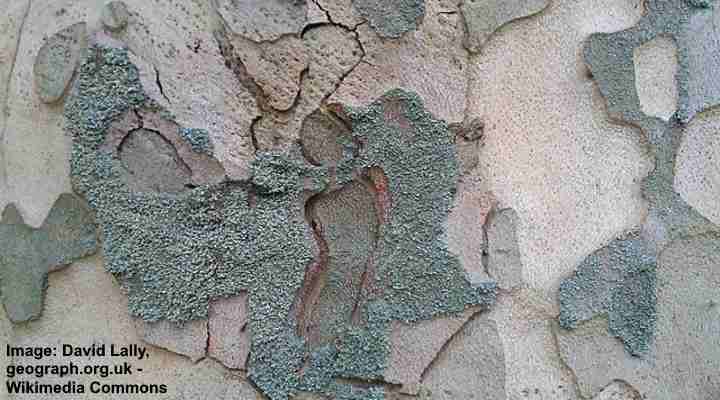
English sycamore bark
Sycamore Maple Tree (Acer pseudoplatanus)

Sycamore maple tree (Acer pseudoplatanus)
Sycamore maple trees are enormous trees. Sycamore maples grow to 115 ft. (35 m), have broad five-lobed leaves, and flaking rough bark that reveals inner orange bark. Although the tree is named sycamore, this tree species is in the genus Acer which means it is one of the types of maple trees.
Also called the plane tree maple, sycamore maple trees thrive in zones 4 to 7. Their native habitat is in Europe, where the towering shade trees thrive in full sun. However, unlike other species of maple trees, the sycamore maple’s foliage doesn’t have any fall color.
Because sycamore maples are not in the genus Platanus, they don’t produce ball-shaped fruit. Sycamore maples have winged fruit that contains a small seed. The sycamore maple seeds are also named helicopter seeds because they grow in a horseshoe shape and often fall to the ground, similar to rotating helicopter blades.
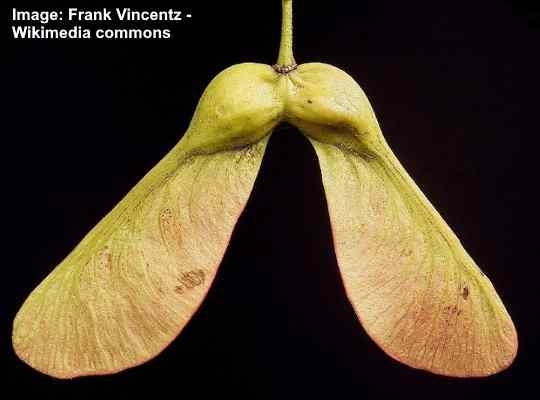
Sycamore maple fruit
Sycamore tree leaves: Sycamore maple tree leaves are dark green and have five lobes with shallow clefts between them. The sycamore maple leaves grow up to 6” (15 cm) across.

Sycamore maple leaves
Sycamore tree bark: Sycamore maple tree bark is smooth and gray. As the maple tree matures, the bark becomes rougher and scaly. As with most species of sycamore or maple trees, the bark peels, giving the trunk a patchy appearance.

Sycamore maple bark
Related articles:
